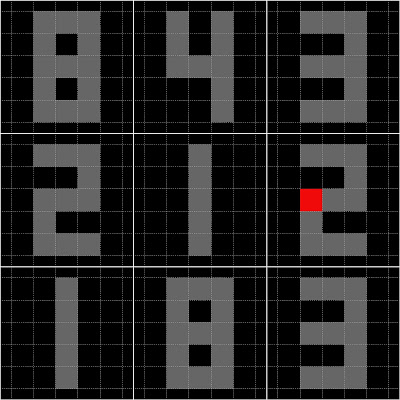
using pure data as a source for sound and visuals, datamatics combines abstract and mimetic presentations of matter, time and space, an art project that explores the potential to perceive the invisible multi-substance of data that permeates our world. Driven by the primary principles of datamatics, but objectively deconstructing its original elements – sound, visuals and even source codes – this new work creates a kind of meta–datamatics. Ikeda employs real–time programme computations and data scanning to create an extended new sequence that is a further abstraction of the original work. The technical dynamics of the piece, such as its extremely fast frame rates and variable bit depths, continue to challenge and explore the thresholds of our perceptions.
 primary grid
primary grid secondary grid
secondary grid organisational structure
organisational structureMy interest in the work of Ikeda is not only in the architectural testing of space in relation to sound frequency, lighting and time but also in relation to the simplistic syntax in which the imagery is representative of such diverse and complex information.
Through the use of algorithm, repetition, sequence and pacific ordering Ikeda’s work translates the most complex information which abstractly surrounds us into simplistic patterns, following generative guidelines.
Test pattern is generated using generative strips which are used in order to organise a series of various components, defined through sequence and rhythm.
Datamatics can be considered as a series of elements (squares) which when arranged within an organisational grid become a component (numbers 0-9). These components are then structured within a larger grid, which is representative of the vastness of information that surrounds us.
There is an interesting relationship as with chemical or physical combinations, where elements form components which are then used to become new elements, each time the purity or impurity of that element is transformed into the purity or impurity of the next, altering properties, cancelling out or promoting reactions.
These patterns can also be considered as the trajectory of components. Test pattern is formed through the linear trajectory of multiple components, whereas datamatics is represented using an abstract trajectory of a single component.
If Ikeda is able to translate such multifaceted unique data into simple patterns generated using simple rules, is it possible to generate unique architecture using similar patterns and generative guidelines?
Mass production has given way to mass customization due to advances in technology and the industrialisation of construction. Systems based on semi prefabrication apposed to the hard prefabricated solutions of the modernists, which saw repetitive complete cellular modules, rather than tactical prefabrication systems based on combinable components. There is a growing importance not for mass repetition, but rather of informatised, (processal, evolutionary, and diversifying) industrial production which permits the conception of a new field of action in the realm of intelligent production system design.
With these intelligent construction systems can the ideas of planners and architects of the 50’s, 60’s and 70’s such Archigram, superstudio and the metabolists begin to form a solution to the evolutionary urban matrix in which society resides today and into the future?


No comments:
Post a Comment